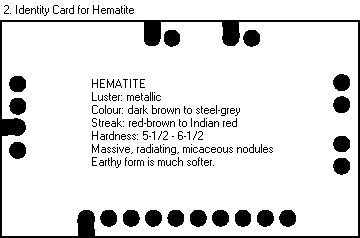|
|
|
Making a Mineral Identifier
By Marilyn Fraser
Materials
To make an identifier for your minerals, you will need a package of 3 x 5 inch file cards and a small hole punch.
Making the master card identifier
- Use one file card to make the master card identifier.
- You will need to make 4 holes along one end of the card for the four divisions of hardness.
- Another side of the card needs two holes for metallic and nonmetallic lustres, and two holes for coloured or non-coloured streak.
- At the bottom, make 10 holes for the major minerals colours.
- This leaves one end of the card. You could punch two sets of two holes for extra use – such as good or poor cleavage and fracture; for "have's" and "have not's" in your collection; or located in your province or not.
Here's what the master card should look like:

Making the identifier card for
mineral specimens
Now, copy the basic mineral information onto the cards. Use one card for each mineral. Sixty sets of data would cover the minerals you are most likely to come across in the field. Cut each card so that the appropriate hole is an open slot.
Here's what an identifier card for hematite would look like:

How to use the identifier
Now, when you test a new mineral and find, for example, that its hardness is between 5½ - 7, you insert a nail or wire into the hole in the stack of cards that corresponds to that hardness. Only the cards for minerals of that hardness will fall to the table when you shake the pack.
Do the same for the other characteristics – luster, colour, streak. By the time you test three or four characteristics, you should only have a few cards to look at to help you to identify your specimen. This is a punch card system and works well for many different things. It was one of the first "computer" systems used.
Copyright ©1998 Marilyn Fraser
E-mail: silver@tor.axxent.ca
This article may not be copied, distributed or reprinted in any form without the author's permission. To contact the author, please use the e-mail address provided. If you are unable to contact the author, please contact the Canadian Rockhound. Authorized reprints must acknowledge the author, original source and the Canadian Rockhound, and include the website URL address of the Canadian Rockhound.
Top of Page
|



